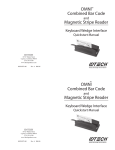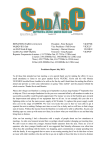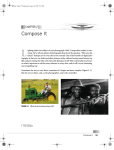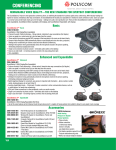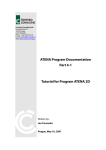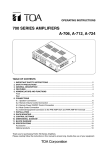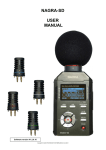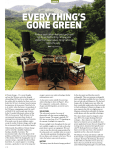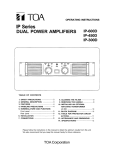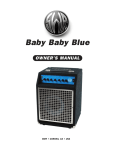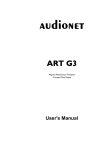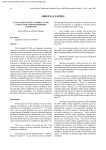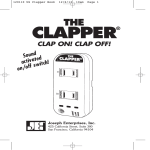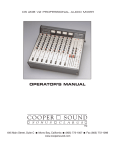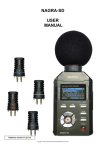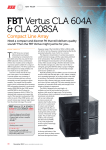Download Nagra VI recorder Issue 65
Transcript
REVIEW NAGRA VI While pondering the meaning of ‘VI’, Greg Simmons checks out the new Nagra six-track location recorder and discovers that size does matter... Text: Greg Simmons Ah, the relentless march of technology... In issue 27 of AudioTechnology [circa 2003] I reviewed this machine’s highly capable predecessor, the Nagra V. It offered two mic inputs, two recording tracks and a ruggedised 40GB removable hard drive, all packaged in a sculpted aluminium enclosure for around $12k AUD. Adding the optional limiters, SMPTE timecode and 24-bit/96k capability pushed that price up to over $15k AUD! Nonetheless, I saw my entire future within its single modulometer and promptly sold my mother on eBay. The Nagra V has been a steadfast and reliable travelling companion ever since. My bedroom is a mess, but it was a fair trade. Five years later the Nagra VI arrives for review. In comparison to its predecessor, the Nagra VI offers twice as many mic inputs, three times as many recording tracks, three times as much storage capacity, limiters, SMPTE timecode, 24-bit/96k capability and more, all inclusive, for less than the entry-level price of the Nagra V it now replaces! As a Nagra V owner, it’s hard not to feel a little disenfranchised... OUT OF THE BOX The first things that caught my attention after unpacking the Nagra VI were its larger-than-expected footprint and its lighterthan-expected weight – in fact, without the battery pack it feels like an empty enclosure. Surely it doesn’t need to be so big? Contrary to assurances from my sex therapist, size does matter when it comes to ergonomics. Ergo, in addition to accommodating a truly informative colour display, the Nagra VI’s size allows all the important controls to be easily accessed on the front panel. There are normal-sized rotary gain knobs that you can actually grip and turn, pushbuttons with sufficient spacing between them to allow fast and confident adjustments, toggle switches that can be flipped with the tip of a finger rather than the tip of a pen, the time-honoured Nagra rotary transport control that makes switching between modes as instinctive as changing gears in a car, and a thoughtfully sculpted front panel that allows your fingers to quickly find their way from one control to another without looking. Likewise, the side panels are large enough to accommodate industry-standard connectors for all inputs and outputs, rather than cramming a cluster of tiny AT 90 oddball connectors into a few square centimetres of precious panel space. In an age of gratuitous miniaturisation, it’s refreshing to see a manufacturer put ergonomics and practical interfacing ahead of cuteness appeal. SO WHAT IS IT? I’ll spare you a blow-by-blow rundown of the Nagra VI’s extensive features and functions because I have no desire to re-write the user manual. That kind of information is readily available online [see ‘Further information’], and no-one contemplating purchasing such a device should do so on the strength of a single review anyway. Instead, I’m focusing on the Nagra VI’s sonic and operational qualities from the perspective of an engineer who regularly uses such a product. The Nagra VI is a six-track location recorder with four mic/line inputs, two line inputs that also serve as AES inputs, an internal four-in two-out mixer with fader and continuously-variable pan controls, comprehensive SMPTE timecode capabilities, a built-in slate microphone (cleverly hidden and protected behind the rotary transport control when not in use), external +12V DC powering via industry-standard four-pin XLR, extensive metadata editing capabilities, high-speed USB 2.0 ports, a Compact Flash card slot, and a versatile monitoring section featuring two MS decoders, an internal speaker and two headphone sockets. Combine all of this with a thoughtfully designed menu system and straightforward navigation controls, and you get the idea. The four mic/line inputs are permanently routed to tracks one to four. Tracks five and six can be fed from the analogue line inputs, the digital AES inputs, or a stereo mix of the four mic/line inputs via the internal mixer. The latter option is of particular interest to those who have to provide a stereo mix of the production/location audio at the end of each day’s shooting – it’s worth noting that this mix can also be routed directly to the removable Compact Flash card, ready to pop out and hand over immediately. Being fully equipped for film work means it can easily tackle less demanding tasks such as recording in concert halls and churches, capturing atmos and ambience, and making field recordings of ethnic music, nature sounds and similar. Fundamental to all of these applications is a good analogue input stage (mic/line preamplifier and A/D converter) and this is one aspect that really sets the Nagra VI apart. Inputs one to four can be switched between mic or line signals, while inputs five and six offer line or AES. The levels for a line input are adjusted via the menu system, with a range of 30dB, adjustable in 3dB steps from +24dBm to –6dBm. Nothing particularly special there, but line inputs don’t require anything particularly special. The mic preamps, however, are a different story. MICROPHONE PREAMPLIFICATION In addition to high-pass filters, phantom power and polarity inversion, each preamp offers two input circuits: one is optimised for condenser mics and provides an electronically-balanced input with 12 sensitivity options from 4mV/Pa to 50mV/Pa, the other is optimised for dynamic mics and provides a transformer-balanced input with seven sensitivity options from 0.8mV/Pa to 3mV/Pa. Phantom power is available on both input circuits, so it’s possible to choose the one that provides the best results. People recording nature sounds and similar low-level signals will appreciate being able to minimise noise by using their condenser mics with the highly sensitive transformer inputs, while those using dynamic mics to capture high level signals will appreciate the additional headroom offered by the less sensitive electronically-balanced inputs. Furthermore, the choice of input circuit may be dictated by aesthetic reasons, e.g. adding the subtle ‘thickness’ of a transformer to the sound of a condenser mic. Whenever one of the mic gain knobs is turned, a horizontal ‘fuel gauge’ appears momentarily on the display showing not only the amount of gain in use, but also the SPL that would be at the microphone capsule if the signal level reached 0dB FS (this value will be accurate if the preamp’s sensitivity has been set to match the sensitivity of the mic being used). For example, if the gain was set to 109dB SPL and the metered level was –6dB, the SPL at the microphone capsule would be 109 – 6dB, or 103dB. The Nagra VI’s predecessor offered a similar SPL metering function and, despite seeming trivial at first, I learnt to appreciate its value over time. It doesn’t take long to get a feel for the right gain setting by simply listening to the sound level at the microphone during set up. Regardless of the microphone in use, if the sensitivities are matched you’ll instinctively know how much gain to use by reading the SPL value – a great bonus when a sound check is not possible! This is far more helpful and intuitive than preamps that use an arbitrary numbered scale, and, combined with the choice of electronic- or transformerbalanced input circuits, reflects the degree of thought that Nagra has put into the design of this product. IN USE You can’t judge gear properly until you’ve put it to work in real-world situations where the pressure is on to deliver. Live music concerts are good tests because they don’t offer any second chances. I was fortunate to have the review unit for one month, during which time I used it to record four performances of Gregorian chant at St Augustine’s church in Balmain, a performance by local chamber choir Coro Innominata accompanied by pipe organ, violin and French horn at St Scholastica’s church in Glebe, and a performance by Austria’s Eggner Trio (piano, violin, cello) at City Recital Hall. The Nagra VI performed without a hiccup. Furthermore, in each of these recordings I was working alongside other engineers and the Nagra VI’s headphone amplifier (with two sockets!) happily drove two pairs of 38Ω Audio-Technica ATH-M50 headphones with no sign of strain. The true test of a location recorder is how well it allows you to make recordings on the move. So I spent half a day on foot catching sounds outdoors with the Nagra VI slung over my shoulder in its supplied carry bag, initially chasing ducks and cyclists around Centennial Park, then crab-walking alongside World Youth Day pilgrims as they sang and clapped their way to Randwick Racecourse. Thanks to its light weight and large footprint, the Nagra VI hung comfortably around my neck and rested agreeably against my stomach, with all controls in convenient reach. There were no problems reading the display in daylight, thanks to its numerous colour and intensity options, and the headphone amplifier easily drove my ATH-M50s to good clean levels above the background noise. No complaints at all. BENEFITS OF INTEGRATION All of the above recordings were made with the same DPA and Schoeps microphones that I regularly use, thereby providing a familiar reference for myself while also pairing the Nagra VI with the calibre of microphones it’s likely to be used with. Based on the results, I have to rank the Nagra VI among the very bestsounding recording devices commercially available – portable or not. That might seem like a big call, but it’s not surprising considering the inherent advantages an integrated and portable machine has to offer. Because it’s a closed box, the output of the mic preamp feeds directly into the A/D converter. This alone has two major advantages over separate components. Firstly, there’s no need for the mic preamp to have a balanced output circuit to interface with external devices; likewise there is no need for the A/D “ Contrary to assurances from my sex therapist, size does matter when it comes to ergonomics. ” Rear-panel connectivity is comprehensive and of a high quality. Both digital and analogue varieties abound. AT 91 The display is easy to read in daylight, thanks to its numerous colour and intensity options. converter to have a balanced input circuit. That’s two considerable chunks of circuitry removed from the signal path. Secondly, the microphone preamp only needs to supply enough gain to feed the input of the A/D converter, rather than having to reach the industry standard nominal operating level of +4dBu for interfacing with other devices – less gain usually means less noise, less degradation and more headroom. Furthermore, because it’s battery powered there are no mains power supply problems to contend with, such as hum and transformer isolation. The result is a highly evolved recording device that produces clear, clean and detailed recordings without sounding etched, cold or clinical. There is no hint of the glare associated with less-thanoptimum A/D conversion, which suggests very good internal clocking, and there is a subtle hint of the liquid warmth I’ve learnt to associate with all signal paths that offer sonic purity from A to D. If you give it a musical signal, it will give you a musical recording. What more could you ask for? NOTHING TO NAG ABOUT The Nagra VI is a sonic and ergonomic joy to use and, thanks in part to that large display, the menu-based user interface is easy to read and very intuitive (ah, so that’s what ‘VI’ stands for!). It represents the culmination of nearly six decades of experience in making location recorders, and it shows – I cannot find any justifiable cause for criticism. Compared to its predecessor, it is considerably more versatile, easier to use, lighter, and sonically superior. Film sound recordists in particular will find its large footprint allows it to sit confidently in the trolley, while its light weight makes over-the-shoulder operation easy. It could also serve double-duty in a recording studio, providing an excellent set of mic pres into a DAW via AES. I admire Nagra’s decision to ignore marketing trends and focus entirely on ergonomics and sound quality when designing the Nagra VI. They have even shunned their own trends, moving away from the aluminium front panels, the aluminium ‘chicken-head’ knobs and the circular electromechanical meters that characterised the classic Nagra look and feel, in favour of a plastic-composite front panel, rubberised knobs and bargraph metering. Despite these cosmetic changes, which have no doubt brought the cost and weight down, the Nagra VI remains a Nagra through and through – it looks and feels a bit different, but it thinks the same and sounds even better. The relentless march of technology, indeed! AT 92 NEED TO KNOW Price $8690 Contact Broadcast Workshop (03) 9329 7655 [email protected] www.broadcastworkshop.com Pros Excellent ergonomics. High quality sound. Versatile microphone inputs. Light weight relative to size. Some users will appreciate the large footprint. Cons Some users won’t appreciate the large footprint. Summary A highly evolved, versatile and sonically excellent location recorder that is precisely the size it needs to be. Nagra’s decision to embrace new materials and technologies works wonders for the price/ performance ratio. Further information An introduction to the Nagra VI can be found here: http://tinyurl.com/NVIintro The Nagra VI’s user manuals can be downloaded from here: http://tinyurl.com/NVImanual In-depth user reviews can be found here: http://tinyurl.com/NVIreview1 http://tinyurl.com/NVIreview2



